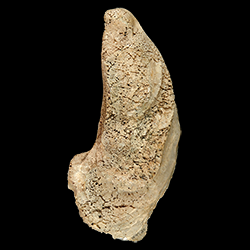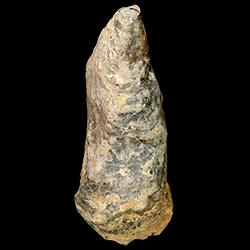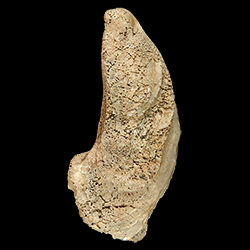
Crassostrea

- Phylum: Mollusca
- Class: Bivalvia
- Order: Ostreida
- Family: Ostreidae
- Genus: Crassostrea
- Common Name: Oysters
Overview
Crassostrea Sacco, 1897.
Key morphological features: Shells show high degree of variation within species, but the shells of most Crassostrea species are dorsoventrally elongated, although young individuals, and occasionally adults, can have shells that are sub-circular in shape. Valves most often subequal, with the left valve generally more inflated than the right valve. No chomata are present on either valve. Many Crassostrea species form bed or reef structures, so the attachment scar on the left valve is often large. The exterior of the valves can have inconsistent radial ribs (usually most prominent on left valve), and most left valves have an umbonal cavity. The single muscle scar is reniform in shape, and most often positioned close to the posterior edge and in the ventral half of the shell. Deposits of chalky calcite are common. Source: Stenzel, H.B. 1971. Oysters. in Cox et al., eds., Treatise on Invertebrate paleontology, Part N, Mollusca 6, Volume 3. The University of Kansas and Geological Society of America. 272 pp.; Harry, H.W. 1985. Synopsis of the supraspecific classification of living oysters (Bivalvia: Gryphaeidae and Ostreidae). The Veliger 28(2): 121-158.
Geological range: Upper Cretaceous to Recent (source: Stenzel, 1971).
Geographic distribution: A distributional map for modern Crassostrea may be accessed from OBIS. A distributional map for ancient Crassostrea may be accessed from the Paleobiology Database.
Diversity: There are 21 recognized living species of Crassostrea (WoRMS, unvetted). The Paleobiology Database recognizes 51 fossil Crassostrea species (unvetted).
Paleoecology: Crassostrea are sessile, filter-feeding bivalves that live permanently attached to hard substrates. Many Crassostrea species are eurytopic, capable of thriving in a range of salinities and temperatures, and Crassostrea species can be found both subtidally and intertidally, with some species attaching to rocks and mangrove roots in addition to conspecifics. Several species preferentially settle on the shells of conspecifics, aggregating to form reef or bed structures. All living Crassostrea species are non-incubatory.
Phylogenetic status: Monophyletic. Recent molecular phylogenetic analyses by Salvi et al. (2014), and references therein, support the monophyly of the genus Crassostrea.

